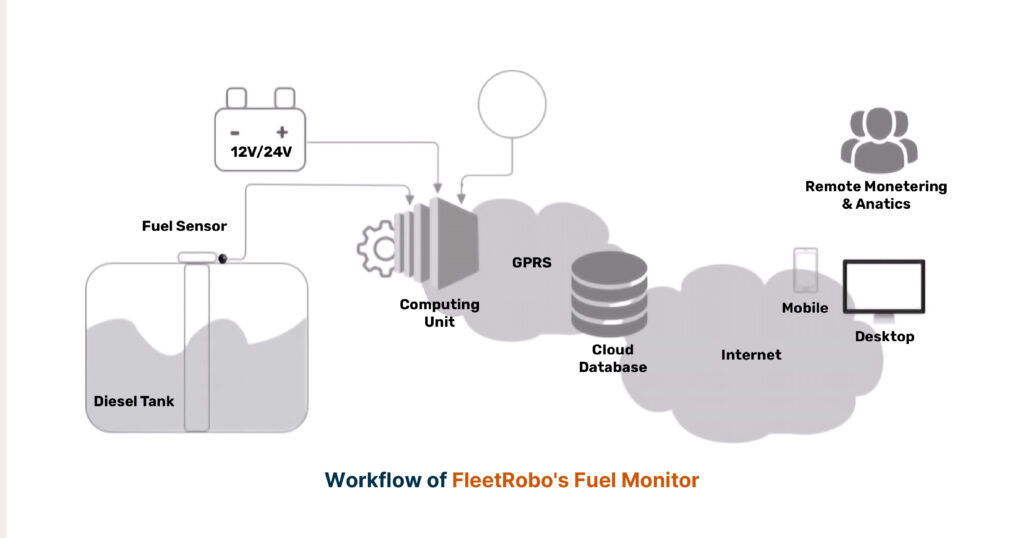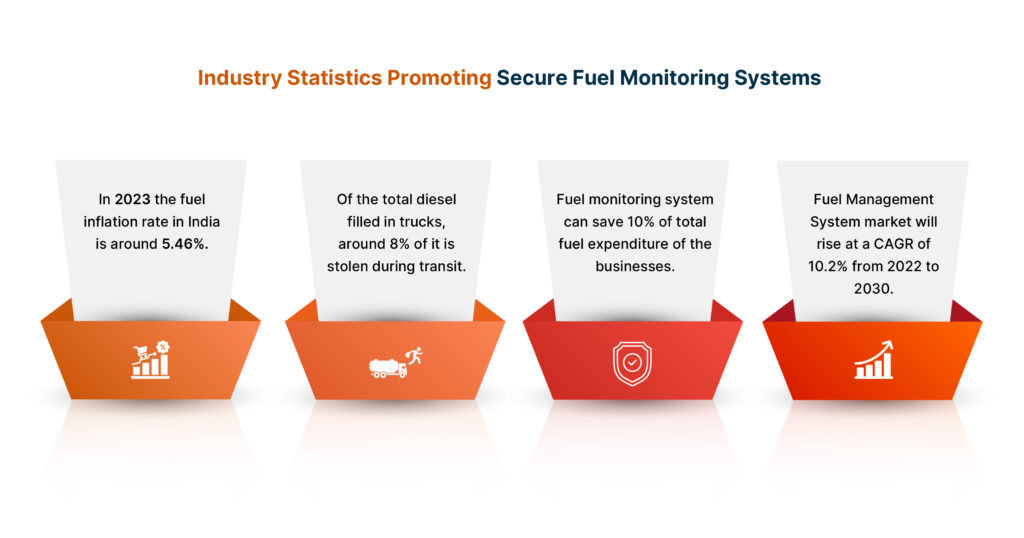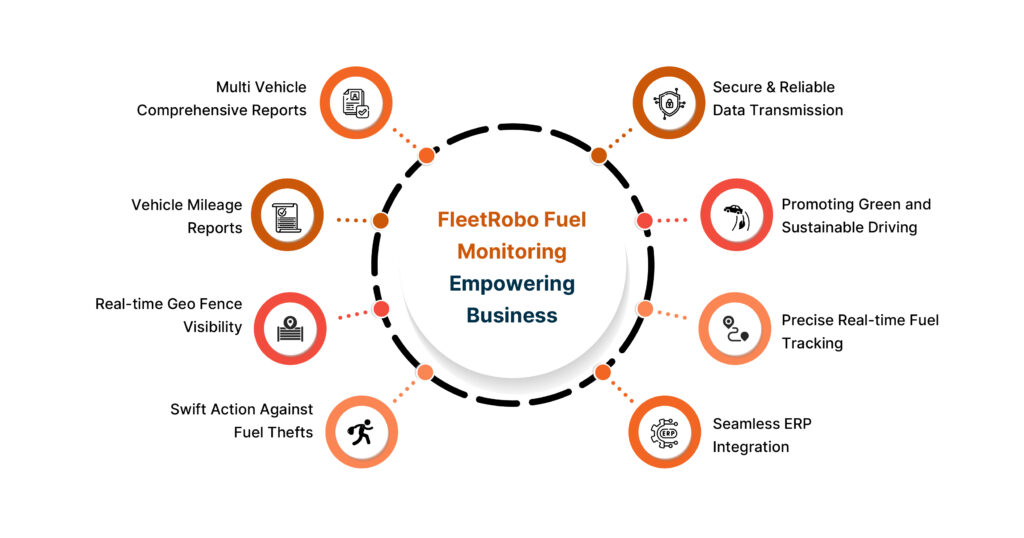With each passing year, fuel prices have been increasing. According to Statistica the inflation rate in India 2023 is around 5.46 percent. So, fuel prices for sure are going to witness an upward curve and with higher operational costs in logistics, it is a must for businesses to have a fuel monitoring system installed in their vehicles. However, what one should look at in fuel monitoring for vehicles remains a big question. This blog is the only guide you need before selecting a fuel monitoring system for your vehicles.
Fuel Monitoring Technology Overview
Fuel monitoring systems are comprehensive solutions designed to efficiently manage and optimize fuel usage. So, fuel monitoring for vehicles involves tracking fuel data from the fleet and analyzing it in a central dashboard to get fuel optimization insights.
Components of Fuel Monitoring Systems
Sensors
Fuel monitoring begins with the deployment of sensors and probes. These devices are installed within vehicle fuel tanks to measure the fuel level accurately. Sensors can use various technologies such as ultrasonic, capacitive, or resistive to determine the quantity of fuel present.
Telematics Integration
Integration with telematics is a key aspect of modern fuel monitoring systems. Telematics technology involves the use of telecommunications and informatics to transmit data over long distances. In fuel monitoring, telematics enables seamless transmission of fuel data to a central server or cloud-based platform. This integration allows for real-time fleet monitoring and comprehensive data analysis.
Info Insight: Telematics penetration in India is expected to cross 15% by the end of 2030 according to telematicswire.com.
Software Solutions
Fuel monitoring systems rely on sophisticated software solutions for data analysis, reporting, and user interface. The software is designed to interpret the data collected by sensors and telematics devices. It provides users, i.e., fleet managers or operators, with user-friendly dashboards to monitor fuel levels, track consumption patterns, and generate MIS reports. These solutions are essential for making informed decisions regarding fuel efficiency.
Read more: Fuel Monitoring Solution
Working Mechanism of Fuel Monitoring Systems

Fuel sensors and GPS transmitters of fuel systems ensure that data is continuously collected and transmitted. Sensors and probes constantly measure the fuel level, and this information is sent in real-time to a central server through telematics integration.
The cloud server then processes the data, taking into account variables such as vehicle speed, engine performance, and driver behavior. The processed information is made accessible via an analytics dashboard, providing valuable insights into fuel consumption patterns, efficiency, and overall performance. Real-time fuel monitoring for vehicles allows for immediate responsiveness to changes, enabling timely decision-making.
Read more: Empower Logistics for Sustainable Growth with Fuel Monitoring
Challenges in Fuel Monitoring for Vehicles

Fuel monitoring, while crucial for efficient fleet management, comes with its set of challenges. A good fuel monitoring solution must address these challenges to ensure accurate, secure, and integrated fuel monitoring for vehicles.
Accuracy Issues
One of the primary challenges in fuel monitoring for vehicles is maintaining accuracy. This can be affected by factors such as sensor calibration drift and dependency on fuel gauges, which can degrade over time. Ensuring precise measurements is critical for reliable data analysis and decision-making.
Limited Frequency of Monitoring
Manual monitoring can only be conducted at set intervals, leading to a lack of real-time data. This delay can hinder timely decision-making and response to potential fuel-related issues.
Time-consuming
Regular monitoring of fuel can be time-consuming, especially for large fleets of vehicles. This process may require dedicated personnel to check and record fuel levels, taking time away from other tasks.
Integration Challenges
Integrating fuel monitoring systems with existing fleet management infrastructure can pose compatibility challenges. Ensuring seamless communication and data flow between different components is essential for an efficient fleet management system.
Read more: Interoperability with FleetRobo APIs
Benefits Unleashed by FleetRobo Fuel Monitoring for Vehicles

FleetRobo’s fuel monitoring system for vehicles is not just a conventional monitoring tool. It’s a full-fledged system to uplift the fleet’s fuel efficiency. FleetRobo fuel monitor for vehicles has numerous advantages, here are some of them.
Info Insight: As per the research published by Straits, the Fuel Management System market will rise at a CAGR of 10.2% from 2022 to 2030.
Instant Alert & Notification: Swift Action to Prevent Fuel Thefts
To give a perspective, of the total diesel filled in trucks, around 8% of it is stolen during transit according to an article published by Motor India Online.
FleetRobo’s monitor sends instant alerts to managers so that they can swiftly counteract instances of fuel theft within their fleet, ensuring that losses are minimized promptly.
Geo-Fence: Virtual Boundary for Vehicles
This fuel monitor for vehicles allows businesses to set up a geo-fence for their fleets. This way companies can have better control over their operating vehicles.
FleetRobo generates instant notifications for unusual activities in real-time. So, businesses get instant notifications in case vehicles get out of the designated geo-fence. FleetRobo guarantees that you stay informed, allowing prompt corrective measures to be taken.
Strategic Action Plans for Cost Reduction
Beyond monitoring, FleetRobo offers strategic insights. With its intrusive reports and user-friendly dashboard, businesses can get quick insights into their vehicle performance. Moreover, FleetRobo provides detailed mileage reports of vehicles for specific time frames i.e. monthly, quarterly, weekly, daily or even for specific trips.
Using these reports businesses can come up with actionable plans to cut down fuel costs and propel their fleet towards optimized operational efficiency.
Deep Analysis for Confident Decision-Making
Businesses with multiple vehicles can generate an overall report for their vehicles with a single click. FleetRobo’s comprehensive report generates an in-depth analysis of fuel usage. So, businesses can track fuel usage per vehicle, fuel usage trends across vehicles, and no of times fuel theft alerts have been generated. All this data is provided in the dashboard in graphical and tabular format. So, companies can navigate through fuel analytics effortlessly with FleetRobo’s user-friendly interface.
Uninterrupted Secure Data Transmission
Transmission of data in fuel monitoring for vehicles should take place in real-time and that too without any interruptions. FleetRobo implements robust encryption protocols to safeguard fuel monitoring data. The data transmitted to the cloud is encrypted and adds an extra layer of protection. This data is sent directly to cloud servers, and due to this companies get uninterrupted fuel tracking. This feature enhances your ability to manage fuel consumption with precision.
Info Insight: As per the cartrack article, the fuel monitoring system can save up to 10% of the total fuel expenditure of the businesses.
Green and Sustainable Practices
Seamlessly align your fleet operations with environmentally conscious practices. FleetRobo empowers you to optimize fuel consumption, curtail emissions, and foster a sustainable operation. By minimizing fuel emissions, businesses can take advantage of carbon credits and make more savings.
Continue Reading: Navigating Global Logistics Emissions with Carbon Offsetting
Real-Time Vehicle Visibility
FleetRobo fuel tracking solution transmits fuel data with up to 2.5-meter location accuracy. FleetRobo fuel monitor comes with both digital and analog fuel sensors. The digital sensor provides fuel tracking accuracy up to 99% and analog ones are 88-90% precise. And with low-power-consuming internal GPS tracking devices, companies can keep an eye on their fleet and fuel levels in real-time.
Seamless ERP Integrations
FleetRobo addresses integration challenges by adopting easy-to-use APIs that facilitate interoperability between different systems. It ensures the seamless integration of the fuel monitoring solution with various telematics devices and fleet management software.
Continue Reading: Revolutionizing Construction: The Power of Fuel Monitoring
Conclusion
FleetRobo can help businesses save money and prevent fuel theft for small to large-scale industry tanks. Its 700mm, 1000mm, 1500mm and 2000mm depth fuel sensors can cater for any vehicle tank or even for that matter it can cater to standalone diesel generators as well. From tracking fuel usage across different construction sites to displaying advanced reports of fuel used by different vehicles in a manufacturing plant, FleetRobo fuel monitor can efficiently improve ROI and reduce business costs. And with its easy mobile monitoring feature, companies can keep track of their fleets simply via a mobile app.
When coupled with a Video Telematics system, the 360 views of the running vehicles can give businesses an in-depth understanding of vehicles and can act as evidence in insurance claims. Moreover, FleetRobo fuel monitor when used together with logistics process automation can automate tasks and save business costs to a greater extent. So, connect with us and shape a smarter tomorrow for fleet fuel tracking.
To get more details please visit the FleetRobo’s website.

